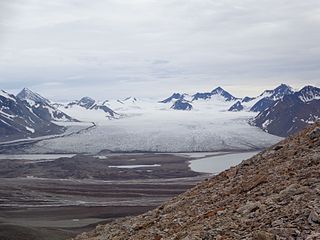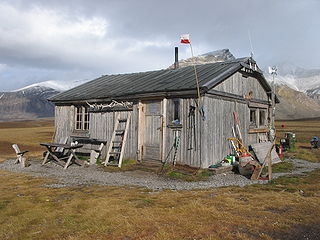Related Research Articles

Oscar II Land is the land area between Isfjorden and Kongsfjorden on Spitsbergen, Svalbard. The 30 km (19 mi) long glacier Sveabreen divides Oscar II Land from James I Land.

James I Land is a land area on the northwestern part of Spitsbergen, Svalbard. It is named after King James I of England and Scotland. The 30 kilometer long glacier Sveabreen divides James I Land from Oscar II Land.
Barentsjøkulen is a glacier on Barentsøya, Svalbard. The glacier covers an area of about 571 km2 (220 sq mi). It is named after the Barents Island, which again is named after Dutch explorer Willem Barentsz. Barents Island is on the Barents Sea.
St. Jonsfjorden is a fjord in Oscar II Land at Spitsbergen, Svalbard. It has a length of 21 kilometer, and opens westwards into the strait of Forlandsundet. Several glaciers debouche into the fjord, including Gaffelbreen and Konowbreen from the north, a merge of Osbornebreen, Devikbreen, Vintervegen, Paulbreen and Bukkebreen at the bottom, and Vegardbreen, Charlesbreen and Bullbreen from the south.
Osbornebreen is a glacier in Oscar II Land at Spitsbergen, Svalbard. It has a length of 21 kilometers, merges with the glaciers Devikbreen, Klampebreen and Vintervegen, and debouches into St. Jonsfjorden. The mountain ridge Goldschmidtfjella forms a six kilometer long nunatak in the glacier.
Vintervegen is a glacier in Oscar II Land at Spitsbergen, Svalbard. It has a length of about 7.5 kilometers (4.7 mi). The glacier borders to the mountain of Klampen, merges with Osbornebreen and other glaciers, and the merged glacier stream debouches into the head of St. Jonsfjorden.

Sveabreen is a glacier between Oscar II Land and James I Land at Spitsbergen, Svalbard. It has a length of 30 kilometer, stretching from Kongsvegpasset at an altitude about 750 meters, and debouching into Nordfjorden.
Sefströmbreen is a glacier in James I Land at Spitsbergen, Svalbard. It is debouching into Ekmanfjorden at the northern side of Isfjorden. The glacier is named after Nils Gabriel Sefström. During a surge in 1896 the glacier deposited large moraine ridges in the inner part of the fjord, and these can be seen at the islands of Coraholmen and Flintholmen. Sefströmbreen is included in the Nordre Isfjorden National Park.
Freemanbreen is a glacier on Barentsøya, Svalbard. It is an offshoot of Barentsjøkulen, reaching down to the sea in the southern direction, into Freeman Strait. The glacier is named after British Alderman Ralph Freeman. The mountain of Buklerimen separates Freemanbreen from the glacier of Hübnerbreen.

Comfortlessbreen is a glacier in Oscar II Land at Spitsbergen, Svalbard. It has a length of about fourteen kilometers, and a maximum width of three kilometers. The glacier debouches into Engelskbukta, after a merge with Uvêrsbreen. Comfortlessbreen is separated from Uvêrsbreen by the mountain range of Trondheimfjella.
Vegardfjella is a mountain in Oscar II Land at Spitsbergen, Svalbard. It is located between the glaciers of Vegardbreen and Charlesbreen, and its highest peak is Larstoppen with a height of 859 m.a.s.l.. The mountain is named after Norwegian physicist Lars Vegard.
Aavatsmarkbreen is a glacier in Oscar II Land at Spitsbergen, Svalbard. It is named after politician and military officer Ivar Aavatsmark. The glacier debouches into Forlandsundet, in the bay of Hornbækbukta. At the southern side of the glacier, between Aavatsmarkbreen and Kaffiøyra, is the mountain range of Prins Heinrichfjella.

Petuniabukta is a bay in Dickson Land at Spitsbergen, Svalbard. It constitutes the northern branch of Billefjorden. The bay is named after the Scottish vessel SS Petunia. Northwest of the bay is the valley of Hørbyedalen and the glacier of Hørbyebreen.
Trollheimen is a mountainous area in Oscar II Land at Spitsbergen, Svalbard, around the glacier of Eidembreen. Among the mountains of Trollheimen are Tussekallen, Runebomma, Heksefjellet, Huldrefjellet, Huldrehatten, Tomtegubben, and parts of Gunnar Knudsenfjella. North of Eidembreen is the glacier of Huldrebreen, and to the south are Heksebreen and Stallobreen.
Løvliebreen is a glacier in Oscar II Land at Spitsbergen, Svalbard. It has a length of about five kilometers, and is located between the mountain ranges of Gunnar Knudsenfjella and Holmesletfjella. The glacier debouches northwards towards St. Jonsfjorden. It is named after Norwegian businessperson Andreas Løvlie along with the nearby mountain of Løvliefjellet.
Heksebreen is a glacier in Oscar II Land at Spitsbergen, Svalbard. It has a length of about 3.5 kilometers, and is a tributary glacier to Eidembreen. The glacier is located south in the mountainous district of Trollheimen, and is surrounded by the mountains of Heksefjellet, Runebomma, Trollungen and Stortrollet.
Venernbreen is a glacier in Oscar II Land at Spitsbergen, Svalbard. It has a length of about fifteen kilometers, and is located between the mountains of Sparrefjellet and Kinnefjellet. The glacier is named after the Swedish lake of Vänern.
Huldrebreen is a glacier in Oscar II Land at Spitsbergen, Svalbard. It is surrounded by the mountains of Huldrehatten, Huldrefjellet and Bytingen, west in the mountainous district of Trollheimen. Huldrebreen and Austgötabreen are located north of the glacier complex of Eidembreen. The glacier is named after Huldra in Scandinavian folklore.
Dunérbukta is a bay at the western shore of Storfjorden in Sabine Land at Spitsbergen, Svalbard. It is named after Swedish astronomer Nils Christoffer Dunér. The glacier of Ulvebreen debouches into the bay. At the northern side of the bay is the mountain of Domen and the ridge Kapp Johannesen.
Hübnerbreen is a glacier at Barentsøya, Svalbard. It is located at the eastern part of the island, and is named after mining engineer and Arctic explorer Adolf Hübner. The mountain of Buklerimen separates Hübnerbreen from Freemanbreen. The coastal plain of Ritterflya, at the east coast of Barentsøya, is formed by deposits from Hübnerbreen and the nearby Reymondbreen.
References
- ↑ "Charlesbreen (Svalbard)". Norwegian Polar Institute . Retrieved 7 March 2013.
- ↑ Arctic Pilot: Sailing directions Svalbard–Jan Mayen. 7. Stavanger: The Norwegian Hydrographic Service and The Norwegian Polar Institute. 1988. p. 249. ISBN 82-90653-06-9.
Coordinates: 78°30′24″N13°21′39″E / 78.5068°N 13.3609°E